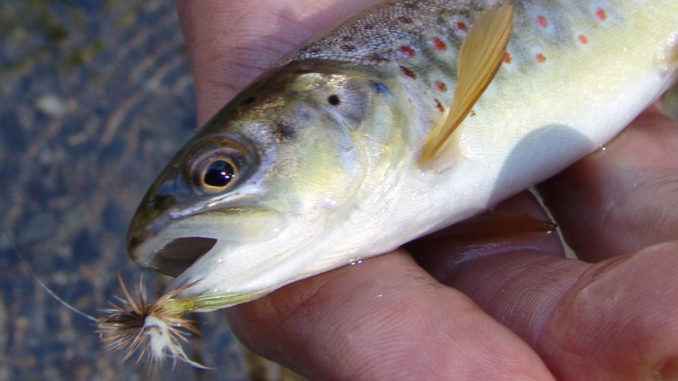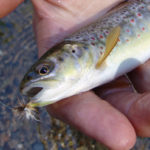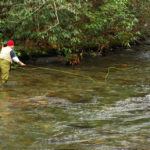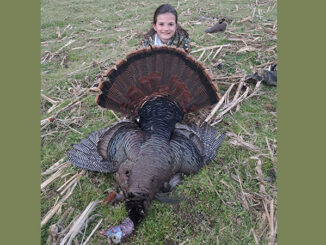
Trout streams should have plenty of water, fish
After a summer of torrential rains, frequent flooding and limited fishing opportunities, trout-fishing conditions are shaping up as the best in years for the fall. Streams are in excellent shape, with plenty of water and plenty of healthy, well-fed trout.
Stocked valley streams still may offer only marginal fishing conditions, but fishing should be excellent in most, if not all, of the wild-trout streams in the two national forests, the Great Smoky Mountains National Park and on the Blue Ridge Parkway.
Delayed-harvest streams switch from catch-and-keep to catch-and-release on Oct. 1, and the N.C. Wildlife Resources Commission has scheduled stockings for October and November. The Tuckasegee River, the biggest and one of the most popular streams in the delayed-harvest system, will get the lion’s share, with 9,800 rainbow, brook and brown trout scheduled to be released each month. The North Toe in Mitchell County will get 8,000, Helton Creek in Ashe County 7,500, the Nantahala River in Macon County 7,000 and the East Fork French Broad River in Transylvania County 6,000. Stockings include equal numbers of rainbow and brook trout and half the number of brown trout.
Several small lakes also are scheduled to be stocked this fall. Cedar Cliff, Bear Lake and Balsam Lake, all in Jackson County, will be stocked in October, and Apalachia Lake in Macon County will get 5,000 trout in December.
An extra bonus for delayed-harvest fishing is that due to limited fishing conditions during the summer, surviving trout from spring and early summer stockings likely will be lunker size.
Fall also is the time brown and brook trout spawn. The spawning ritual begins as early as mid-September and can continue into November, depending on weather and stream conditions.
Of the two species, the brown trout is the most visible and most active. The male brown trout’s colors, especially the distinctive red spots on its sides, become more vivid, and males develop a pronounced hook or kype in the lower jaw. At the beginning of the cycle, adult browns leave their usual hiding places in deep pools and begin moving upstream, searching for likely places to spawn. During this period, brown trout feed heavily, building up strength and stamina. This is a prime fishing time for brown trout, and the constant movement can continue for a couple of months since all brown trout do not spawn at the same time. They’re easy to find, easy to see, and much easier to catch.
Large flies such as Nos. 12-10 chartreuse, olive, or black Woolly Boogers are especially effective for pre-spawn browns. Kevin Howell of Davidson River Outfitters in Brevard says browns will hit Woolly Boogers because they think they’re salamanders. Other deadly flies are a No. 10 Bitch Creek Nymph and a No. 12-10 Girdlebug. Spinning lures such as a 1/4-ounce Mepps Aglia or a Panther Martin with a black body and yellow dots also work well on pre-spawn trout.
During the actual spawning, neither the male nor female feeds. The male, however, will strike at anything he sees is a threat to the female or her eggs. Once the eggs are laid and covered, the browns’ parental duties are over; the eggs and subsequent fry are on their own. Eggs can survive even if temperatures drop to below zero, as long as the water doesn’t freeze — a rarity for high-gradient southern Appalachian streams. Once eggs are laid and covered, they remain in the spawning beds, or redds, through the winter, hatching usually between mid-January and mid-March.
When spawning is completed, browns return to their previous haunts. For post-spawn brown trout, egg patterns such as Glow Bugs are very effective because brown trout often eat the eggs and young of other trout.
Brook trout follow much the same spawning patterns as browns. Prime spawning time for brook trout is mid-October through mid-November. Since wild brook trout usually are found in small streams, they don’t move as far as browns.
As for catching either brook or brown trout during the spawning cycle, fishery biologists say angling activity does not adversely affect a spawn if a trout is not injured or played to exhaustion when it’s caught. When released, the trout will resume its spawning activities. The key word is “release.” Kill a spawning trout, and you’ve destroyed an entire generation of trout.
The best places to find larger brown trout during the spawning cycle are in the tributaries of large streams. Recommended flies for fall fishing are Orange Caddis, Blue-Winged Olive, yellow Stimulator and Orange Palmer in sizes ranging from a No. 16 to a No. 12. Effective nymph patterns are red Copper John, black Girdlebug with yellow legs, Secret Weapon, Brown Stone and Sheep Fly in sizes No. 14 to 10. Terrestrials also are excellent fall patterns, especially grasshopper, beetle, ant and inchworm patterns. Terrestrials can be fished until the first heavy frost. Size should match the actual insect.
This fall likely will be remembered fondly as one of the best trout-fishing seasons in recent memory.







Be the first to comment